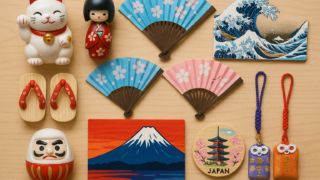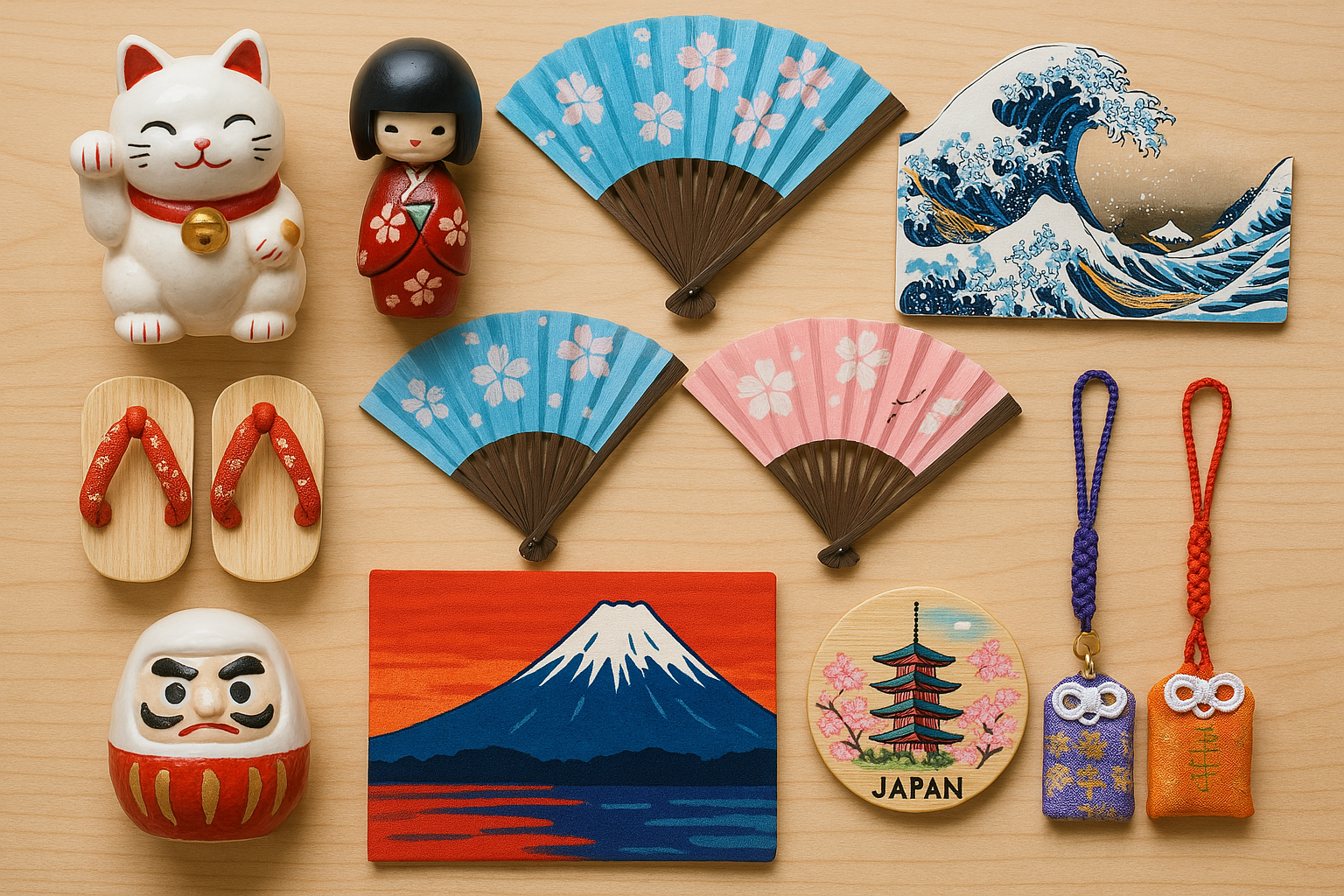- Introduction: Why Kyoto is a Souvenir Paradise for Tourists
- 1. Kiyomizu-yaki Pottery – A Piece of Kyoto’s Rich Craftsmanship
- 2. Kyoto Furoshiki – A Versatile Cultural Gift
- 3. Nishijin-ori Textiles – Kyoto’s Signature Silk Weavings
- 4. Matcha and Tea-Related Products – A Taste of Kyoto’s Tea Culture
- 5. Kyoto Sweets – Traditional Treats for Your Sweet Tooth
- 6. Japanese Fans (Uchiwa and Sensu) – A Cool, Elegant Souvenir
- 7. Kyoto Incense – Scents That Evoke Peace and Serenity
- How to Shop for Traditional Souvenirs in Kyoto
- Conclusion: Take a Piece of Kyoto Home With You
Introduction: Why Kyoto is a Souvenir Paradise for Tourists
Kyoto isn’t just about beautiful temples, tranquil gardens, and bustling streets; it’s also a treasure trove for souvenirs. As you stroll through the city, you’ll notice that each corner holds a unique piece of history and craftsmanship. These souvenirs aren’t just trinkets; they are meaningful artifacts that tell the stories of Kyoto’s rich cultural heritage. Whether you’re a seasoned traveler or a first-time visitor, Kyoto offers you the chance to take home a part of its soul. From delicately crafted pottery to world-renowned matcha, there’s something here that will capture your heart and remind you of your unforgettable time in Japan.
1. Kiyomizu-yaki Pottery – A Piece of Kyoto’s Rich Craftsmanship
What is Kiyomizu-yaki Pottery?
If you’ve ever seen a beautifully painted ceramic piece in Japan, there’s a good chance it’s Kiyomizu-yaki pottery. Named after the famous Kiyomizu-dera temple in Kyoto, this pottery style dates back to the 17th century and is known for its elegant design and intricate craftsmanship. With a rich history deeply intertwined with Kyoto’s culture, each piece of Kiyomizu-yaki is handmade, often featuring beautiful, nature-inspired patterns. Think of it as the art of storytelling, but through clay – capturing the essence of Japan’s natural beauty and peaceful spirit.
Why It’s a Must-Buy in Kyoto
Picture this: You’ve just walked through the historic streets of Kyoto, enjoyed a serene visit to Kiyomizu-dera, and then stumbled upon a shop selling hand-painted Kiyomizu-yaki. It’s the perfect souvenir to capture the essence of your trip – a timeless piece that carries the spirit of Kyoto with you. These ceramics aren’t just decorative; they’re functional too. Whether you’re sipping tea from a delicate teacup or serving dinner on a beautiful plate, Kiyomizu-yaki brings a touch of elegance to your home. Plus, you’ll feel like you’ve brought a piece of Kyoto’s tradition into your own life.
2. Kyoto Furoshiki – A Versatile Cultural Gift
What is Furoshiki?
Furoshiki is a traditional Japanese wrapping cloth that dates back over a thousand years. Used for wrapping and carrying items, furoshiki is as functional as it is beautiful. It comes in various sizes, colors, and patterns, with designs ranging from simple and elegant to bold and playful. It’s like having a Swiss Army knife in cloth form – not only is it a lovely gift, but it can also be used for countless purposes, such as a scarf, bag, or even as a decorative centerpiece in your home.
How to Use Furoshiki: Beyond Just a Souvenir
Here’s where the magic of furoshiki truly shines. Imagine it as your multipurpose travel companion. You can wrap a gift with it, turn it into a stylish bag, or even use it as a picnic blanket when you’re out exploring Kyoto’s lush gardens. Personally, I’ve used mine on countless occasions – from wrapping up snacks for a picnic to carrying home my favorite souvenirs from local markets. It’s not just a souvenir, it’s a piece of Kyoto’s resourceful spirit that can become a part of your daily life, adding a dash of Japanese elegance wherever you go.
3. Nishijin-ori Textiles – Kyoto’s Signature Silk Weavings
The Story Behind Nishijin-ori
Nishijin-ori is Kyoto’s crown jewel in the world of textiles. This traditional silk weaving technique has been practiced in the city for over 1,000 years and is considered one of Japan’s most intricate and prestigious forms of weaving. Each piece of Nishijin-ori is crafted by skilled artisans using a loom, with the thread patterns telling a story of craftsmanship passed down through generations. The result is luxurious fabric used for everything from kimono to elegant bags and scarves. You could say it’s the high couture of Japanese textiles, and owning a piece of it is like owning a tiny bit of Kyoto’s royal history.
Perfect for Fashion Enthusiasts
If you’re a fashion lover, then Nishijin-ori is a must-have souvenir. Imagine walking through the streets of Kyoto in the elegant glow of Nishijin-ori fabric, feeling the craftsmanship and history woven into every thread. From kimono accessories to modern bags, you can find a variety of stylish items that feature this luxurious textile. I personally own a Nishijin-ori wallet, and every time I pull it out, I’m reminded of the sophisticated and timeless beauty of Kyoto’s textile traditions. Plus, it makes for a fabulous conversation starter when you’re back home!
4. Matcha and Tea-Related Products – A Taste of Kyoto’s Tea Culture
Why Kyoto is Famous for Matcha
Kyoto is often considered the birthplace of matcha, with the city’s Uji region being home to some of the world’s finest green tea. For centuries, monks in Kyoto’s temples have cultivated and refined matcha, a powdered green tea known for its vibrant green color and rich flavor. When you visit Kyoto, you’ll see matcha everywhere – in lattes, desserts, and even savory dishes. If you’ve never experienced it before, prepare to have your taste buds awakened by this earthy, slightly sweet, and refreshing beverage that’s as much a cultural experience as it is a drink.
Matcha-Inspired Souvenirs
From matcha-flavored chocolate to beautifully crafted tea sets, Kyoto is a haven for matcha lovers. When I was in Kyoto last time, I picked up a traditional matcha whisk (chasen) as a souvenir, and let me tell you, it’s a game-changer when you make your own tea at home. But matcha isn’t just about the drink itself; it’s also about the experience. The matcha-flavored sweets, like matcha-flavored mochi or ice cream, are an absolute treat and a must-buy when visiting Kyoto. Bring home a tin of Uji matcha or a beautifully crafted tea bowl to recreate the Kyoto tea ceremony vibe in your own kitchen!
5. Kyoto Sweets – Traditional Treats for Your Sweet Tooth
Famous Kyoto Sweets to Try
Kyoto is well known for its traditional sweets (wagashi), which are made with the finest ingredients and have a delicate, artful presentation. One of the most famous is yatsuhashi, a sweet made of rice flour and sugar, often filled with red bean paste and flavored with cinnamon. You’ll find these treats in every corner of Kyoto – from local shops to tea houses. For those who love more refined sweets, wagashi is a must-try. These treats are often made for tea ceremonies, offering a perfect balance to the bitterness of matcha tea.
How to Pack Sweets for Travel
Now, I’m sure you’re thinking, “How on earth do I bring these delicate sweets home without them turning into crumbs?” Don’t worry – I’ve been there too! Many local stores offer packaging that keeps the sweets fresh and intact. If you’re taking wagashi or yatsuhashi, be sure to ask for the special travel packaging. It’s a lifesaver. And, while they’re a delicious souvenir to share with friends and family, I recommend buying a little extra for yourself – trust me, it’s hard to resist these sweet temptations!
6. Japanese Fans (Uchiwa and Sensu) – A Cool, Elegant Souvenir
The Art of Making Japanese Fans
Fans are a symbol of Japan’s cool elegance, and Kyoto is home to some of the most beautiful ones. Uchiwa (round fans) and sensu (folding fans) are crafted with care, often adorned with intricate designs that showcase Kyoto’s artistic heritage. Whether it’s a fan painted with delicate flowers or a minimalist design, these fans are a work of art. The process of making a sensu, in particular, is labor-intensive and requires master craftsmanship. The fans are often seen in traditional Japanese dance performances, adding a graceful touch to every movement.
Practical and Decorative: Why You Should Get One
Japanese fans aren’t just pretty; they’re practical too! When the summer heat hits, nothing feels better than a cool breeze from a fan, especially one made with such beautiful craftsmanship. On my trips to Kyoto, I’ve always picked up a sensu fan as a souvenir. It’s light, portable, and adds a touch of elegance to any room. They also make fantastic gifts – whether you’re using it at home or hanging it on the wall as a piece of art, a Japanese fan is a souvenir that keeps on giving.
7. Kyoto Incense – Scents That Evoke Peace and Serenity
The Role of Incense in Japanese Culture
Incense has a deep spiritual significance in Japan, particularly in Kyoto, where it is closely tied to Zen Buddhism and the peaceful atmosphere of the temples. Kyoto’s incense is made using natural ingredients like sandalwood, aloeswood, and cinnamon, and is considered a medium for calming the mind and soul. When you light a stick of Kyoto incense, it’s like inviting a piece of tranquility into your space. The calming aroma can enhance meditation, relaxation, or even just a quiet moment with a cup of matcha.
Best Kyoto Incense to Take Home
If you’re looking for a souvenir that’ll bring peace and calm into your life, Kyoto incense is an excellent choice. Brands like Shoyeido have been making incense in Kyoto for centuries, and their products are world-renowned for their quality and soothing aromas. I’ve brought back a few boxes of Kyoto incense, and every time I light one, it reminds me of the calm serenity I felt when walking through the city’s temples. Plus, the packaging is so beautiful, it makes a wonderful gift for someone who appreciates a little peace and mindfulness in their life.
How to Shop for Traditional Souvenirs in Kyoto
Where to Find Authentic Souvenirs
Kyoto is full of charming shops and markets where you can find authentic souvenirs. From the bustling Nishiki Market to small family-owned shops tucked away in the historic streets of Gion, there’s no shortage of places to find these traditional treasures. If you’re looking for high-quality items, I recommend heading to the smaller, specialized boutiques where artisans showcase their crafts. It’s always better to buy directly from those who make the products – you’ll often hear stories about the craftsmanship and passion behind each item.
What to Keep in Mind While Shopping
When shopping for traditional souvenirs, it’s important to look for authenticity. Be wary of mass-produced items that lack the uniqueness and craftsmanship of Kyoto’s true traditional products. One of my personal tips is to check the craftsmanship – is it finely made? Does it have a personal touch? If you’re ever unsure, don’t hesitate to ask the shopkeeper about the history or process behind an item. They love to share their knowledge and stories with visitors, and it’s a great way to ensure you’re buying something truly special.
Conclusion: Take a Piece of Kyoto Home With You
Kyoto offers a wealth of traditional souvenirs that perfectly encapsulate the city’s spirit, culture, and history. Whether you choose a beautiful piece of Kiyomizu-yaki pottery, a versatile furoshiki, or some soothing Kyoto incense, each souvenir allows you to take home a unique part of Kyoto’s soul. These souvenirs aren’t just items – they’re reminders of your unforgettable experience in one of Japan’s most culturally rich cities. So go ahead, spoil yourself with a piece of Kyoto to treasure forever.






コメント